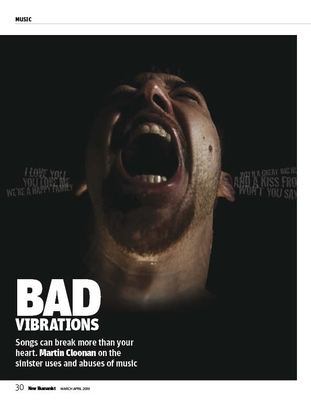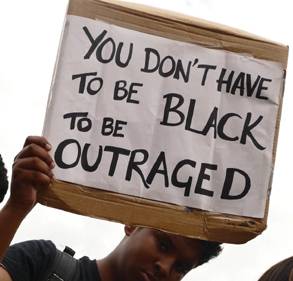 Hit me baby One More Time. I Predict a Riot. Beat It. Street Fighting Man. Popular music titles are replete with apparent injunctions to violence. But how far are they ever acted upon? How often does music cause violent behaviour? Can music itself be a form of violence?
Hit me baby One More Time. I Predict a Riot. Beat It. Street Fighting Man. Popular music titles are replete with apparent injunctions to violence. But how far are they ever acted upon? How often does music cause violent behaviour? Can music itself be a form of violence?
Some alleged links are part of popular mythology: the music of pantomime Satanist Marilyn Manson has been associated with the massacre at a Columbine high school in the USA, the murder of nuns in Italy and the murder of schoolgirl Jodi Jones in Scotland. Ozzy Osbourne was once accused of promoting suicide and Ice T’s record “Cop Killer” was the alleged inspiration for the murder of police. Extreme metal bands have been implicated in burning churches in Norway and members of the Beasts of Satan metal band in Italy were convicted of murdering fellow band members and associates in 2004.
However, despite this catalogue, many would still choose to dismiss any supposed causal relationship between music and violence as the prerogative of moralist conservatives who seek to blame culture for crimes which have other, less dramatic origins. Others might choose to defend freedom of speech and the right of alienated young people to assert their identities – however noisily.
But these traditional arguments about the relation between music and violence need to be expanded so as to accommodate the increasing use of music not as a stimulant to violence but as violence in its own right. We now have numerous accounts of the use of music by the US military in torture sessions in Iraq and Guantánamo Bay. In May 2003 it was revealed that US forces in Iraq were using music to disorient prisoners being held in shipping containers. Songs played at the prisoners included Metallica’s “Enter Sandman” and, most notoriously, Barney the Dinosaur’s “I Love You” song. At the “Camp Nama” multiple-agency interrogation unit at Baghdad International Airport “high-value detainees” were first of all sent to a “Black Room”, a garage-sized, windowless space painted black where rap was blared at them.
Perhaps unsurprisingly, media accounts of such incidents of musical torture were often characterised by their triviality. The use of Barney the Dinosaur’s “I Love You” song proved to be a real rib-tickler for some. When reported on the NBC’s Stars and Stripes the reporter, Ann Curry, played a clip of Barney and assumed a jokey tone of voice that drew laughter from the studio audience. The show’s weatherman, Al Roker, joked: “And if Barney doesn’t get ’em, switch to the Teletubbies, and that crushes ’em like a bug.” When Newsweek broke the story the editor added a last line to the article – “It broke us too!” In the UK, even the Guardian covered the story as a joke.
In fact musical torture is far from being a laughing matter. While right-wing commentators rushed to dismiss the notion that playing music to detainees could properly be torture, the reality is that being forced to listen repeatedly to any sound with no control and no idea when it will begin or end is highly damaging. (The British army knew this when it employed white noise against Republican detainees in Northern Ireland in the early 1970s.) This quickly emerged when Bruce Johnson and I turned to the role of music in neighbourhood disputes while researching our book The Dark Side of the Tune. We found incidents from across the globe of neighbours using music to upset others. Often what began as a request to turn sound down escalated into another form of sonic warfare, resulting in court injunctions and physical violence – including murder. The precise music was immaterial. Any music, from Beethoven to The Beatles, can be used violently, to create what the victims repeatedly spoke of as “torture”.
Human beings need some control over their acoustic environment, whether they are in a prison cell or a luxury home. The fact that media accounts have tended to trivialise neighbourhood disputes involving musical violence again suggests that the politics of sound is still not being taken seriously enough.
Meanwhile once UK citizens leave their home further problems of the acoustic environment arise. They will routinely visit lots of places where music will be used to modify their behaviour – restaurants, shops, airports, pubs. Music is being used to make them behave in ways that they have not freely chosen. If they’re young, this control may be especially aggressive. Across the globe “square” music (such as classical or Middle of The Road) has been used to dissuade young people from gathering in public spaces such as shopping malls or train stations. In the UK a device called the mosquito, only audible to the young, has been used to keep them from gathering near shops. Sound has become a weapon to turn public into private space.
In part what is at stake in all this is that music matters. Our musical tastes are key components of our subjectivity and we do not like it when they are abused. We like it still less when music we dislike is imposed on us. Thus the young will move on if they dislike the music of the malls. Their tastes are being sonically attacked. Meanwhile in the cells of Iraq and Guantánamo Bay prisoners are assaulted by music, with the aim of “breaking” them psychologically. The link is the assault on identity and the lack of control.
Some musicians have begun to fight back and demand control over the use of their music, calling on governments not to use it as part of their psyops weaponry. On the 60th anniversary of the Universal Declaration of Human Rights, a campaign called “Zero dB” was launched by a collective of musicians backed by the British Musicians Union. With support from high profile artists including Massive Attack, Elbow and Rage Against The Machine, Zero dB are planning a series of “silent protests” to draw attention to the issue and to demand that states uphold the ban on using loud music as torture imposed by the European Court of Human Rights. In the US there has been encouraging talk of artists, including big names like Bruce Springsteen and Britney Spears, using copyright law to prevent the use of their music to “break” prisoners.
Perhaps the sensitivity shown by such artists to the prospect of their work being misused as torture might also alert us to the possibility that this might be the very word employed by our immediate neighbours to characterise our own Sunday morning high volume playing of Mahler’s 9th.
Martin Cllonan's most recent book is Dark Side of the Tune: Popular Music and Violence (Ashgate), written with Bruce Johnson.

